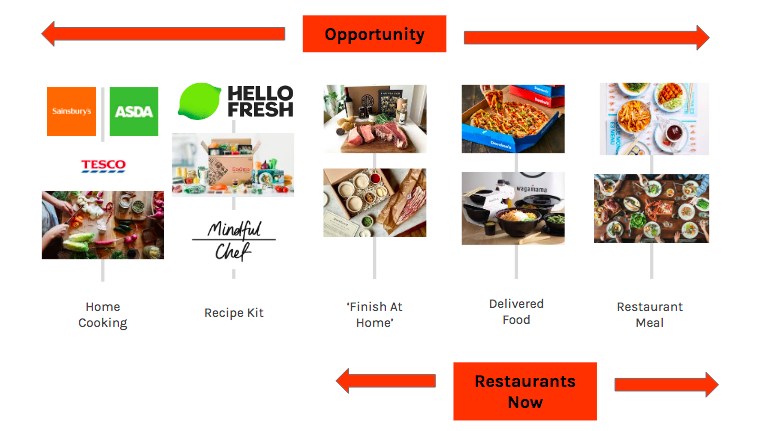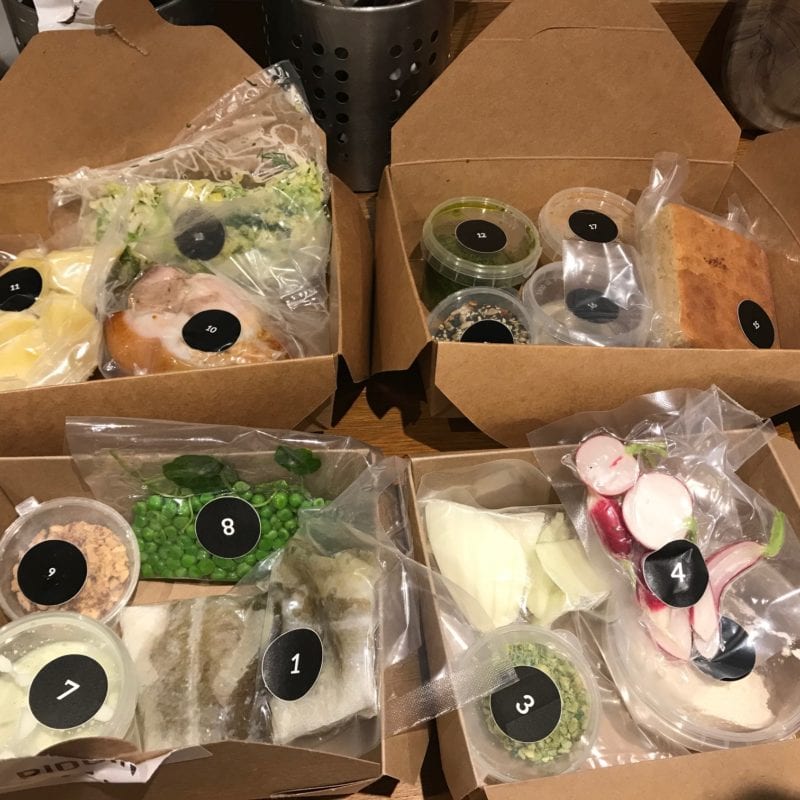Strategy
8th April 2021
The question on everybody’s lips: “As restaurants reopen, will there still be consumer demand for restaurant meal boxes at home? Surely people would prefer to visit a restaurant once they can – and if I continue selling meal kits, will I just cannibalise my restaurant sales?”
Let’s break it down.
Occasionality is Key
Research has shown that most meal kit purchases during lockdown are for special occasions. Yes, some of those special occasions may move back into restaurants (in which case: win for you) but there’s evidence to suggest that lots of people want to continue the party from the comfort of their own homes. People with young kids at home for example, have embraced “dining out at home”, especially at the premium end of the market.
“We love eating out but babysitters are expensive and we don’t like calling on family too often. We’ve been getting meal kits at least 3-4 times a month during lockdown – we’ll definitely carry on after lockdown lifts, it’s an extra treat that’s super-convenient” – Caroline, Walthamstow.
There are also people for whom distance has been a simple but significant barrier. If they don’t live near you, they can’t visit you regularly. Data from Fuse, the ecommerce platform, which London-centric brands like Hawksmoor and D&D London use to sell kits, shows that more than 65% of meals kits are distributed outside of London; evidence that meals kits enable you to reach people in all corners of the UK, establishing your brand in entirely new geographical segments.
As well as a likely increase in working from home, there will be lots of people who are cautious about venturing out and there will be a gap there. And there are a host of other at-home occasions restaurants can tap into, that don’t compete with the experience of going out to a restaurant:
The Wider Market
Zooming out a bit, and considering the market outside of the context of the Covid crisis, recipe kits have been a growing trend for years.
As Bob van Dijk, Head of Naspers, one of the world’s most successful technology investment firms, said: “The notion that people gather a bunch of ingredients from a shop and put things together three times a day, 30 times a month – that’s not the way things are going to work any more.”
We’re in a period of rapid change in how we buy, prepare & consume food. Not just in the takeaway category (up 13% in the year pre Covid, without taking down the restaurant industry), but the emergence of other categories like recipe kits and meal boxes – these existed before Covid but sales were accelerated by the lockdowns. People are simply no longer buying all of their food for consumption at home in the supermarket. They are embracing these new products, which are characterised by online purchase, convenience and, increasingly, subscription models.
There is a spectrum emerging, offering consumers more choice, and blurring the lines between home-cooked / convenience food / restaurant food. There is an interesting space in the middle, that restaurants could move into, flexing between recipe kits – “finish at home” – delivered food, depending on the needs of the consumer. This could also allow restaurants to logically move into the ‘home cooking’ category too of course, with branded sauces, produce or ready meals on supermarket shelves, already a familiar sight from household names.

The recipe kit market is currently estimated to be worth £500m annually and is expected to reach £1bn over the next few years (source: The Grocer, May 2020). Mindful Chef has annual sales of £50m (and was recently acquired by Nestle). Gousto’s like for likes were up 115% 2020 vs 2019 and sold 5m meals per month. HelloFresh was in similar growth.
As if to prove the point, Tesco is now trialling ‘restaurant-quality’ meal boxes, to capitalise on the rising popularity. Their collection (starting at £20) includes chicken or duck confit and ox cheek. Tesco said: “…we’re keen to offer our customers something special at home. These boxes come without the hassle of a home-cooked meal but with all of the satisfaction and bragging rights.”
Tesco imitating restaurants doing meal kits…

The point is that how people cook and eat food is diversifying. Whether it’s scratch cooking, following a recipe from a kit, “finishing at home”, or getting a takeaway, there’s loads of opportunities for restaurants to create products for the eat at home market.
The competition is not your own restaurant but Tesco and Sainsbury’s; Gousto and Hello Fresh.
Getting the Product Right
It’s clear that restaurant meal kits can grow into the Hello Fresh area – there is space for restaurant brands there – and it’s ripe for innovation. You have to get your products right.
A good “meal kit menu” should showcase what’s best about your brand, whilst not trying to replicate your restaurant food verbatim, or do a poor impression of it. Aside from the practicalities, it’s a good idea to keep your offerings distinct, always keeping in mind the needs of the consumer and the different occasions you’re targeting.
At home, there’s a big opportunity for kits that allow people to mix things up and experiment. The ability for people to customise their meal and most certainly a greater accommodation of vegan, vegetarian and nutritional requirements is needed.
You should consider kits that cater to different levels of prep time and skill. For some it’s part of the fun and for others, working through 24 tiny labelled containers is the stuff of nightmares (especially for a midweek “can’t be bothered to cook”).

Party sizes are important too – can people scale up what they order from you? Sharing feasts and parties at home are a nice opportunity to increase transaction value – ideal for people who love to host more than they like to cook. M&S’s party food range be gone! I want to entertain my mates with food from my favourite restaurant brand, please.
Maintaining regular customers will require constant innovation; more choice is needed, regular new dishes to break menu fatigue, seasonality to consider. Not to mention universal special occasions like Valentine’s and Mother’s Day.
It will require the same level of menu engineering that you put into your regular restaurant menu.
Survival of the Fittest
With all this to consider, there will inevitably be a reduction in supply, with many operators simply unable to make the operation viable whilst simultaneously running restaurants. Doing any sort of significant volume will require premises, supply chain and resources for menu development, production and marketing. But with fewer competitors in the market there’s a greater opportunity to take market share.
Wondering whether people will still want meal kits after lockdown is like wondering whether people will still eat food at home. 🤔
Restaurants need to break the notion that meal kits replicate (or replace) restaurant experiences at home. This isn’t hospitality, its retail.
The answer is yes, people will still eat food at home.
The question is, do you want to be the one selling it?
Sign up for your dose of creative inspiration.
What services are you looking for?
Please select a service
Strategy & planning
Website
Marketing
Technology solutions
Branding
CRM
Other
Tell us about your project and what you want from us, this will help us prepare for our call.
What’s your budget?
Please select a budget
Less than £10k
£10-£40k
£40k +
Your Information
Business Type
Location
Please select your location
UK
USA
Europe
Global
How did you hear about Ignite?
I've worked with you previously
Found you online
Recommended by Ignite client or collaborator
Saw an Ignite advert or social
Through Clutch
Other
Tick the box to receive insight, opinion and inspiration from Ignite Spunta la casella per ricevere la newsletter
Please note that by submitting this form you agree to us storing your contact details and contacting you in regard to your query. Our privacy policy is available on our website with full details on our commitment to protecting personal data.
We'll be in touch soon!
Your Information
Tick here if you'd like to receive insight, opinion and inspiration from Ignite Please tick to receive newsletters


Ignite have joined forces with Screen Pilot to form the world's leading marketing agency for the hospitality, travel and leisure markets.
Same team. Same world-class results. Now with more firepower - and the data to back it up.
Head over to our new site to see what’s next. Or call us on 020 7697 0151 to discuss your project.